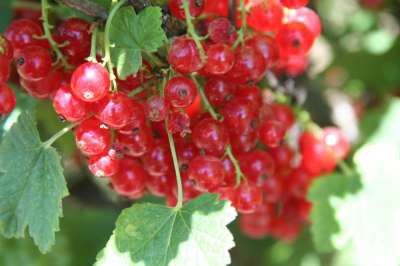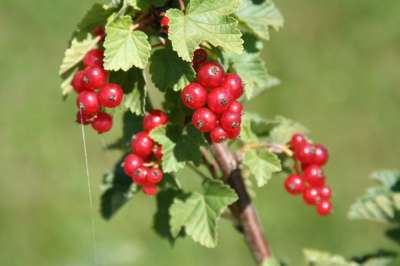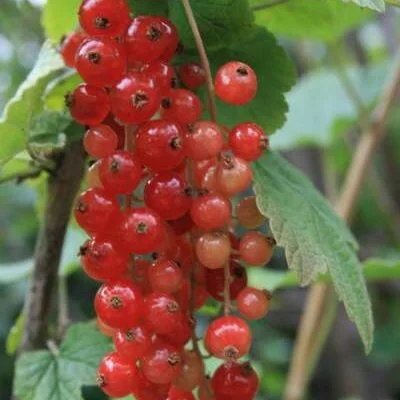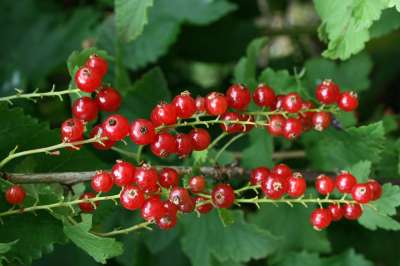Your basket is currently empty!
Growing Redcurrants in pots and containers
This is a perfectly practical solution to those short on space. A container size of not less than 20-24” is adequate or you may wish to invest in some half barrels. A good proprietary all purpose compost mix is suitable and the bushes should be planted individually, one to a container. Planting of redcurrant with bare rooted bushes can take place from October to April and is the most convenient time to plant them. But you can also plant from pot grown bushes into larger containers you have obtained and this can be done at any time during the growing season.
View our online catalogue of redcurrant bushes.
It will take 1-2 years for your bushes to begin cropping. Pruning should be undertaken as described above but feeding is quite different because you wouldn’t use granulated fertilizers designed for use in the open ground, not on container grown specimens and it is very difficult to get the dosage right. I find Osmocote tablets the easiest way to feed them, and it is easily applied. You just need to push one tablet deep into the compost, at the side of the container is easiest as the roots are less compacted there. This one tablet breaks down slowly and predictably and eakes out it’s feed over several months, infact it will last the bush for one growing season. The best time to feed is late winter or early spring just as the bushes are thinking about producing active growth. There is no point in feeding in the Autumn or Winter because the bushes have no use for it and so much of the food will have leached out by the time growth has started.
You can also augment the Osmocote tablets with maxicrop seaweed extract, used as a foliar feed or diluted and watered straight to the roots.
I would not recommend keeping your currant bushes in their containers for any longer than 5 or 6 years. After this it’s better to plant them out somewhere or discard them, and start again.
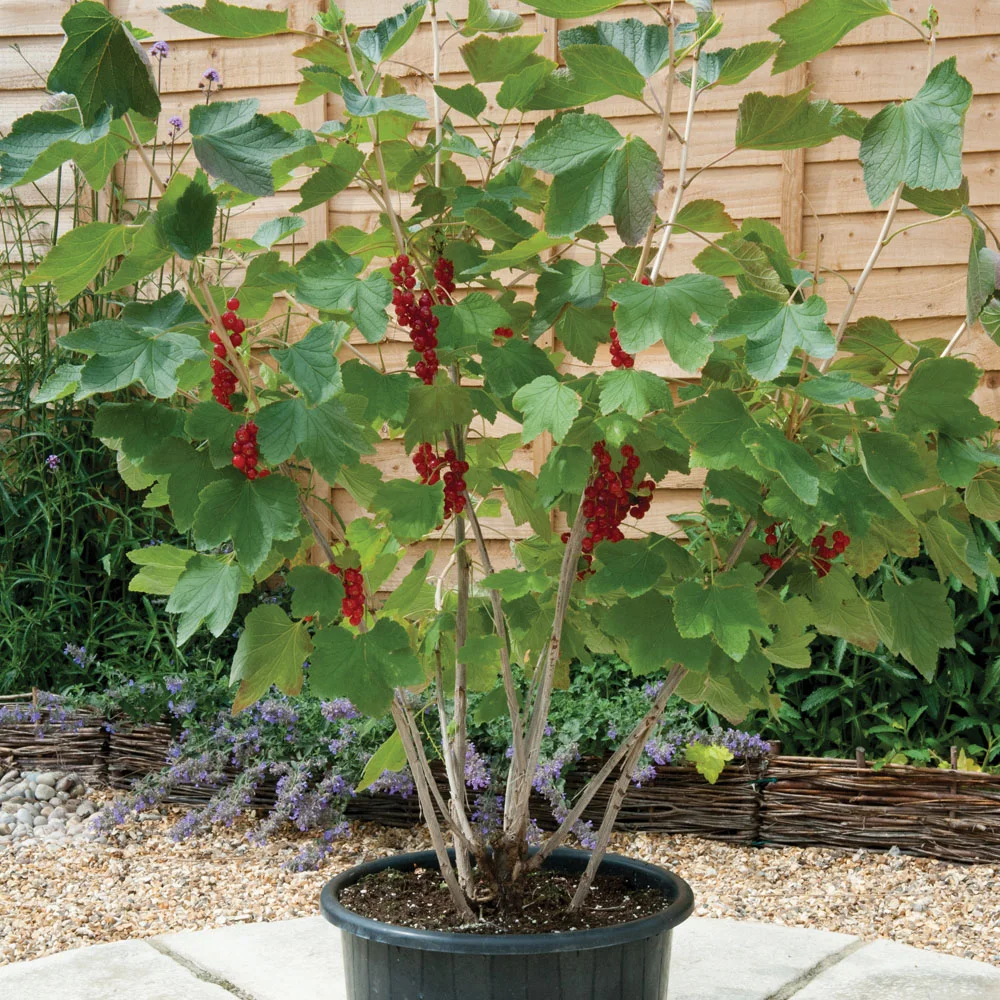
Two points to remember: the fruits can ripen earlier with plants grown in pots because the compost itself is liable to be so much warmer, so remember your season will be earlier than comparable bushes grown traditionally in the ground. And this same key point – that the compost tends to wamr up more quickly and stored it heat for longer in the close confines of a container – can also lead to early summer dormancy. It is not uncommon for the bushes to start shedding their leaves in late summer just after they have finished fruiting. This might make you assume something is wrong and the bushes are sick but normally it is nothing to worry about and they grow away again as normal in the Spring of the next year. Placing the bushes in a cooler spot or keeping the roots shaded as much as possible can avoid this happening.
Watering is of course very important because the bushes are entirely reliant on what you give them. Even if it rains quite steadily you may find that little of it permeates the compost because the foliage canopy above shields the compost from the rain. It is also might more liable to drain off or evaporate more quickly because the compost is hotter. So it’s good practice to provide a daily watering regime, no matter what. You can up the quantity given as the fruits begin to swell, so that they attain the greatest size and are also juicy. Sometimes currant bushes grown in pots can produce rather dry fruit if they haven’t been given generous irrigation. Other than this they are easy and worthwhile to cultivate in such a way.
Growing redcurrant and whitecurrant standards
This used to be a very specialised method of cultivation that you would see very seldom but it seems to be accelerating in popularity because it is seen as a space saving option by way of elevating the bush onto a standard stem that can be planted beneath with strawberries or herby. Such a feature is similar in stature to a standard rose and is an attractive formal feature that can either be grown in the open ground, or in a large container. It should be staked wherever it is grown because the head can get top heavy. Generally this type of currant is grown on a stem of around 1 metre in length, the stem itself should be kept clear and any growth rubbed off as soon as it appears because this would be growth from the rootstock which you don’t want. The head of the bush itself should be treated just like a normal currant bush as regards pruning.
Fertilizing the flowers
All known varieties are self pollinating so there are no issues in this respect and even bushes grown on their own will fruit to capacity. Also there is issue with growing red and white currants together. The flowers are usually pollinated by bees and other day flying insects so encouraging a local population with generous nectar rich flowers nearby has been proven to increase yields via optimum pollination. The flowers appear in May and are long and greenish, clustered all beneath the branches. I think they are quite attractive, in an unusual kind of way!
The redcurrant season
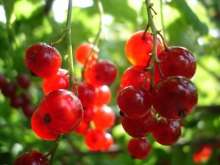
You can expect your first ripe fruits at the turn of June/July and different varieties will then ripen in sequence through July. There is a small number of extra-late varieties that give you season extension into August and these are Redpoll, Redstart and Augusta. They are well worth growing so that you can pick your currents over the greatest possible time. At the other end of the scale ‘Junifer’ is generally the earliest variety to ripen.
Whitecurrants do not share quite the same seasonal variation as not as much breeding work has been carried out on them, but Blanca is a recent introduction that fruits late, after the other varieties and is worth looking out for.
Harvesting
You should pick your just rewards when the berries have ripened evenly on the strig and all display a good bright colour. Normally the berries are picked with the strig intact; this is because the berries are prone to splitting or damage when detatched from the stalks [strig] and will start to lose juice. So it is best to remove them only when you are ready to use them. With whitecurrants it may be more difficult to judge when they are properly ripe, if you haven’t grown them before. They should not really have any green tinge and be a pearlescent cream white, infact some may take on a pinkish tinge when properly ripened and this is when they are at their sweetest.
So that’s it I hope this is all you could possibly need to know in order to cultivate red and whitecurrants to the highest standard. Certainly one of the most enjoyable of the soft fruits to grow, when in full fruit a redcurrant looks like it is bedecked with jewels as the fruits sparkle so in the sun, Whitecurrants are a great favourite here also and deserve greater appreciation. They are sweeter than Redcurrants – ideal for eating fresh but no less versatile as the make a jelly the colour of sweet champagne and add an extra dimension in fruit cocktails and fresh fruit displays.



